
Understanding Tractor PTO Winches: A Sustainable Solution
Sustainable forestry demands efficient, environmentally conscious practices. Tractor PTO (Power Take-Off) winches offer a powerful and surprisingly eco-friendly solution for logging operations. By directly harnessing your tractor's power, these winches minimize fuel consumption, reduce ground disturbance compared to heavier machinery, and allow for selective logging, preserving the forest ecosystem. This guide provides a comprehensive overview of how to choose, operate, and maintain a PTO winch for optimal sustainable forestry practices. For more on tractor implements, check out this helpful resource.
Types of Tractor PTO Winches: Matching Capabilities to Needs
Several types of PTO winches cater to various needs and budgets. Each offers a distinct balance of capabilities, cost, and ease of maintenance:
- Hydraulic Winches: These offer smooth, controlled pulling power through hydraulic fluid. Their precision makes them ideal for challenging terrain and delicate situations. Higher initial cost and more complex maintenance should be considered.
- Mechanical Winches: Simpler, more durable, and typically more affordable than hydraulic winches, they require less maintenance but may demand more physical effort during operation. They are robust and reliable.
- Wireless Hydraulic Winches: Combining hydraulic power with remote control, these enhance safety and efficiency by allowing operation from a safe distance. The increased convenience comes at a higher price point.
A detailed comparison reveals the key differences:
| Winch Type | Typical Capacity (lbs) | Speed (ft/min) | Power Requirement (HP) | Pros | Cons |
|---|---|---|---|---|---|
| Hydraulic | 10,000 - 50,000 | 50 - 200 | 40 - 100+ | Smooth operation, precise control, versatile | Higher cost, complex maintenance, costly potential repairs |
| Mechanical | 5,000 - 30,000 | 20 - 100 | 20 - 60 | Simpler, durable, low maintenance, affordable | Less precise control, more physical effort required |
| Wireless Hydraulic | 10,000 - 40,000 | 60 - 150 | 50 - 80 | Enhanced safety, increased efficiency, ease of use | Highest initial cost, potential signal interference |
Note: Specifications vary by manufacturer and model. Always consult manufacturer data.
Choosing the Right Winch: A Step-by-Step Guide
Selecting the appropriate winch involves careful consideration of several factors:
- Tree Size: Larger trees demand higher pulling capacity.
- Terrain: Rugged terrain necessitates more powerful winches with robust cables.
- Budget: Factor in initial purchase price, maintenance costs, andpotential fuel savings. Explore financing options to make sustainable forestry more accessible.
- Frequency of Use: Regular use justifies investment in a higher-quality, durable model.
Asking yourself: "How will this winch impact my annual logging operations?" helps make the right purchasing decision.
Safe Operation and Maintenance: Prioritizing Safety and Longevity
Safe operation is paramount. Always:
- Inspect thoroughly: Check cables, bolts, and hydraulic lines (if applicable) before each use.
- Use appropriate safety gear: Gloves, eye protection, and steel-toe boots are essential.
- Adhere to manufacturer instructions: Understanding the manual prevents accidents.
- Never exceed the winch's capacity: Overloading can lead to serious injury or equipment damage.
Regular maintenance is critical for winch longevity:
- Lubrication: Keep moving parts lubricated to prevent wear and tear.
- Cable Inspection: Regularly check for fraying or damage. Replace worn cables promptly.
- Hydraulic System Checks (for Hydraulic Winches): Monitor fluid levels and check for leaks.
Environmental Advantages: Minimizing Your Footprint
PTO winches contribute directly to sustainable forestry:
- Reduced Ground Disturbance: Minimizes soil compaction and erosion.
- Lower Fuel Consumption: Significantly reduces fuel use compared to larger equipment.
- Selective Logging: Enables targeted harvesting, preserving the forest ecosystem.
"Using a PTO winch decreased our fuel costs by 25% and reduced ground disturbance by 40%," says Dr. Emily Carter, Forestry Research Specialist at the University of Washington.
Cost Analysis: Long-Term Financial Benefits
While the initial investment can be significant, long-term savings from reduced fuel consumption and increased efficiency often justify the cost. A thorough cost-benefit analysis comparing PTO winches to traditional logging methods should be undertaken.
Regulations and Safety Standards: Compliance and Legal Considerations
Always abide by local, state, and federal regulations regarding equipment operation and forestry practices.
Conclusion: A Sustainable Investment for the Future
PTO winches represent a valuable investment in sustainable forestry by offering improved efficiency, reduced environmental impact, and long-term cost savings. They empower responsible logging practices, ensuring the health of our forests for generations to come.